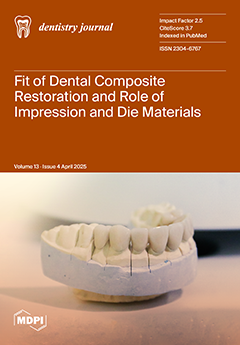(1)
Background: Natural-looking dental restorations require careful selection of the restorative material, with color and translucency characteristics similar to the natural dental structures. (2)
Objectives: This research aimed to evaluate if there is compatibility regarding the color and translucency between different commercial RBCs in different layering recipes. (3)
Methods: Sixty 1 mm thick disk specimens were produced from three different RBCs: ESS (Essentia-GC), BEG (Brilliant Ever Glow-Coltene), and IPS (IPS Empress Direct-Ivoclar Vivadent). Three different opacities and translucencies (enamel, dentin, and opaque shades) from each system were used in four recipes (R1-enamel, R2-dentin, R3-enamel and dentin, R4-enamel, dentin, and opaque) to obtain single-, double-, and triple-layered samples, respecting the anatomical layering technique. CIE L*, a*, b*, C*, h
0 coordinates were recorded, and the relative translucency parameter (RTP
00) was calculated. Further, the color differences (ΔE
00) and the difference in translucencies ΔRTP
00 were analyzed between the materials and between the layered recipes. (4)
Results: The CIE L* and h° color coordinates and RTP
00 showed significant differences among all three RBCs for all four recipes (
p < 0.001). The decreasing order of translucency for each recipe was R1: ESS > BEG > IPS, R2 and R3: BEG > IPS > ESS, R4: BEG > ESS > IPS. Important differences were found in color and translucency among the recipes for each of the three RBCs tested (
p < 0.001). The decreasing order of translucency for the tested RBCs was ESS: R1 > R3 > R4 > R2, BEG and IPS: R1 > R3 > R2 > R4. (5)
Conclusions: No significant compatibility was observed in color and translucency among different layering recipes of the same composite materials nor between similar layering recipes when using different composites. The color differences between materials were more significant than the differences in translucency for each recipe.
Full article






